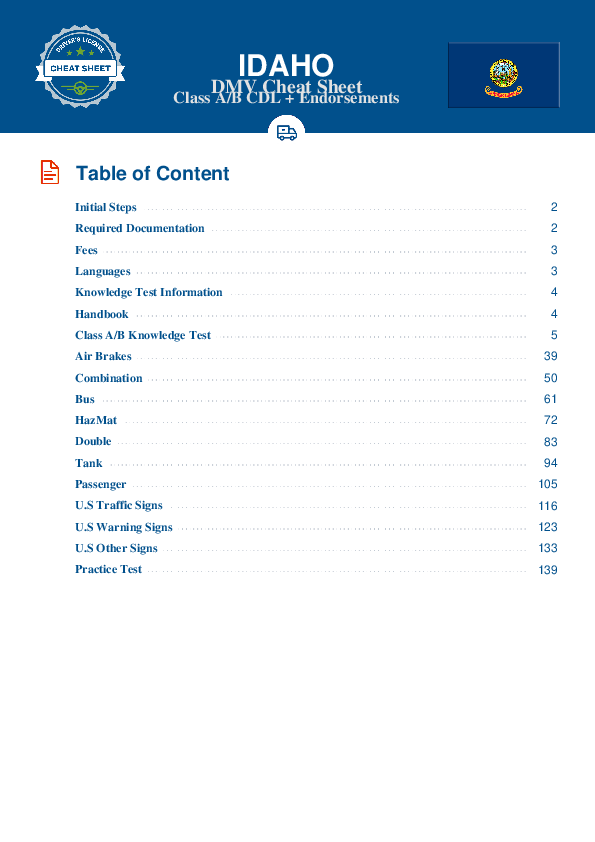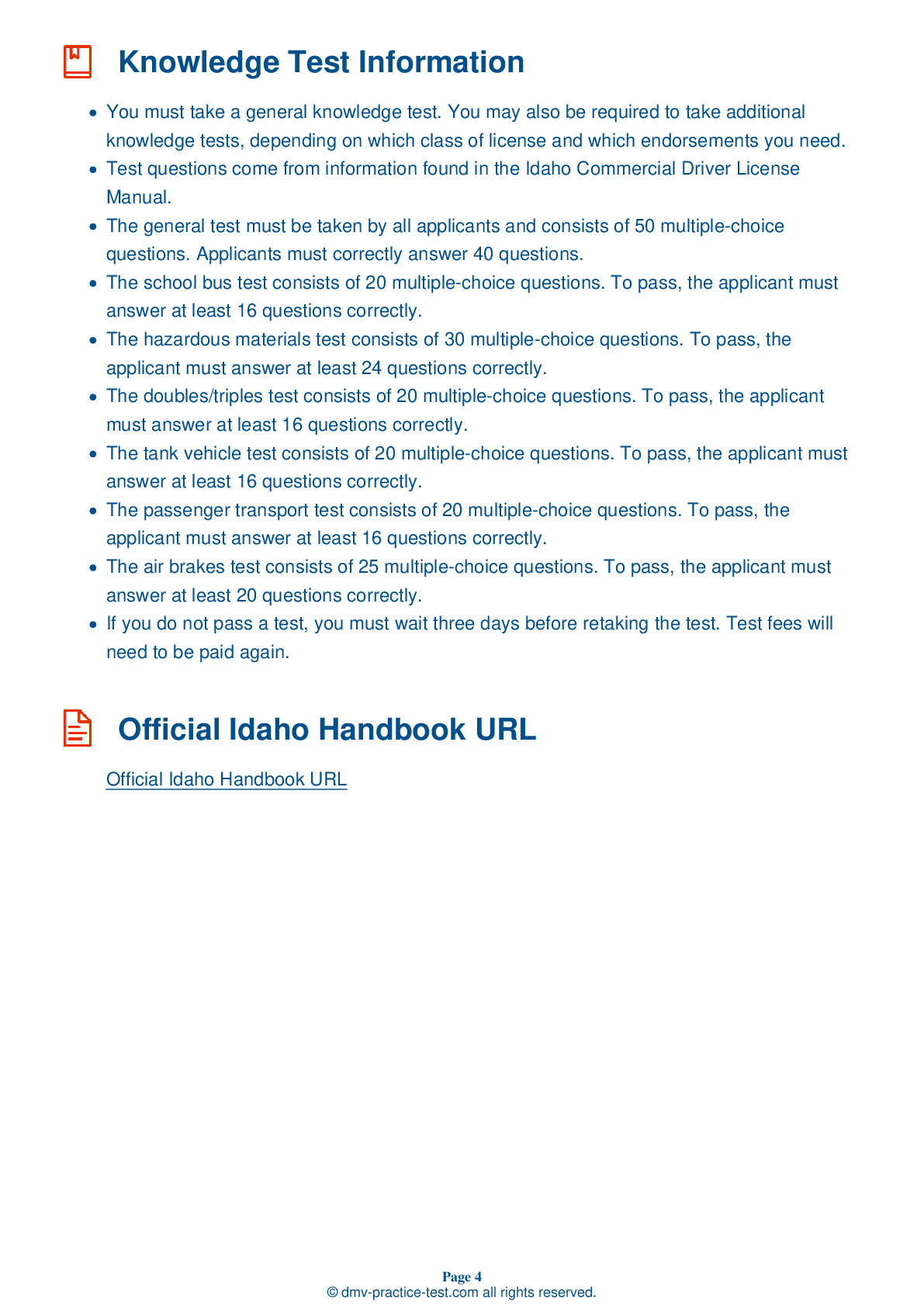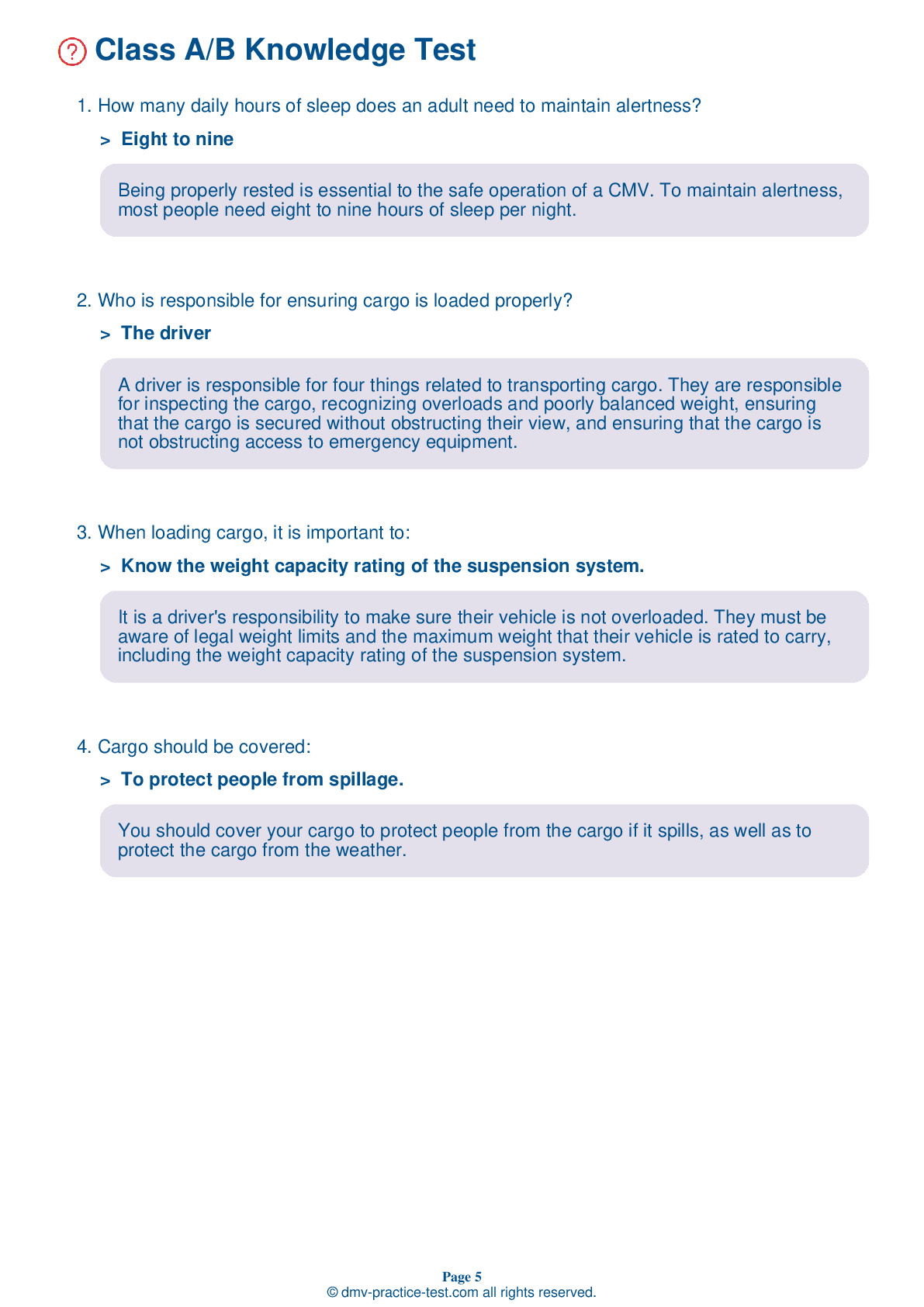Knowledge Test Class A #1
Class A Driving Test | Idaho 2025 #1 Page 3 of 7
Train for FREE online with our Idaho class A license test. The official exam test consists of several obligatory parts, with all of them checking your knowledge of different blocks of road rules. If you need to obtain a ID CDL class A permit in 2025, practice as much as possible. Free sample tests published on our website will help you check and improve your knowledge and boost your grades. Please bear in mind that CDL class A requirements may vary from state to state.
50
40
20
15 . When backing a truck, you should:
Backing a commercial motor vehicle is always dangerous because you cannot see everything behind you. When backing, make frequent checks of the mirrors on both sides of the vehicle.
16 . If a load is 10 feet long, it must be secured by a minimum of ____ tie-downs.
On flatbed trailers and trailers without sides, cargo must be tied down. There should be at least one tie-down for every 10 feet of cargo. Regardless of the size of the cargo, at least two tie-downs must be used.
17 . Which of the following is not a sign of fatigue?
Potential warning signs of fatigue include difficulty focusing, frequent blinking, or heavy eyelids; yawning repeatedly or rubbing your eyes; daydreaming; wandering or disconnected thoughts; trouble remembering the last few miles you've driven; missing exits or traffic signs; having trouble keeping your head up; drifting from your lane; following too closely; hitting a shoulder rumble strip; or feeling restless and irritable.
18 . When traveling down a steep downgrade:
On long and/or steep downgrades, you should primarily use engine braking to control the speed of your vehicle. Use your brakes only as a supplement to this effect.
19 . Friction in an S-cam brake is caused when the brake shoes and linings:
Friction inside a brake drum is caused when the brake shoes and linings push against the inside of the drum. The friction in the drums will slow and stop the vehicle.
20 . If your brakes fail on a downgrade, your best hope to stop is to:
If your brakes fail on a downgrade, you will have to look outside your vehicle for a way to stop. Using an escape ramp is the safest way to stop your vehicle.
21 . Be sure that your wheel bearing/seals are:
During an inspection, ensure that the wheel bearing/seals are not leaking.
2025 Idaho | Frequently Asked Questions
To acquire a CDL Hazmat endorsement in Idaho, you must first possess a valid Idaho Commercial Driver's License (CDL). After that, you will need to pass the Hazardous Materials Endorsement Knowledge Test. Lastly, you should complete a federal security threat assessment application, provide fingerprints, and pass an FBI background check. The endorsement will be added to your CDL once approved.
To obtain a CDL Hazmat license, you must first have a valid Commercial Driver's License (CDL). You must be at least 21 years old and be able to read and speak English. You also need to pass a physical examination every two years. Lastly, you must pass the Hazardous Materials Endorsement Knowledge Test and an FBI background check.
When applying for a CDL Hazmat endorsement, you need to provide proof of U.S. citizenship or legal status, such as a birth certificate or passport. You also need your current Commercial Driver's License (CDL), proof of Idaho residency, and your Social Security Number. Finally, you'll need to complete a federal security threat assessment application and provide fingerprints for an FBI background check.
Yes, there is a dedicated written test for the CDL Hazmat endorsement in Idaho. This test assesses your knowledge on transporting hazardous materials safely. It covers topics such as loading and unloading, bulk packaging marking, driving and parking rules, and emergency response procedures. The Idaho Commercial Driver’s License Manual is a great resource to prepare for this test.
The written test for the CDL Hazmat endorsement covers a wide range of topics related to hazardous materials. These include identifying different types of hazardous materials, understanding shipping papers, placarding rules, loading and unloading procedures, handling emergencies and incidents, and understanding the associated risks and safety precautions when transporting hazardous materials.
Yes, obtaining a CDL Hazmat endorsement in Idaho involves extra charges. You'll need to pay a fee for the knowledge test, and there's also a fee for the endorsement itself. Additionally, the TSA background check carries a separate fee. The exact costs can vary, so it's recommended to check the current fees with your local DMV office or on their website.
Yes, to obtain a Hazmat endorsement in Idaho, the Transportation Security Administration (TSA) requires a federal background check and fingerprinting. This is to ensure the driver doesn't pose a security threat. The applicant must be a U.S. citizen or have legal status, and must not have committed certain crimes.
Yes, specialized training is required for a CDL Hazmat endorsement. Applicants must pass a written test on federal and state regulations for transporting hazardous materials. While it's not mandatory, many opt for professional training programs to prepare. After passing the test, a TSA background check is also required before the endorsement is granted.
No, you cannot legally transport hazardous materials without a valid CDL Hazmat endorsement in Idaho. The endorsement ensures that drivers are trained and equipped to handle hazardous materials safely. Violating this requirement can lead to severe penalties, including fines and suspension or revocation of your commercial driver's license.
Yes, you can add the CDL Hazmat endorsement to your current CDL license. It doesn't require a new application for a CDL, but it does require passing a written test specific to Hazmat transportation, as well as a TSA background check. Once these are successfully completed, the Hazmat endorsement can be added to your existing CDL.



